ENS6126 Project: Geopolymer Concrete Properties & Anchor Study
VerifiedAdded on 2022/12/29
|21
|4720
|1
Report
AI Summary
This report investigates the structural performance of geopolymer concrete and structural anchors, aiming to highlight the benefits of geopolymer concrete over traditional cement-based concrete in terms of safety and environmental impact. It explores the mechanical behavior and structural characteristics of reinforced geopolymer concrete, focusing on aspects like elastic modulus, steel-concrete bond, and compressive strength. The study also examines the performance characteristics of anchors under varied load conditions, evaluating failure modes and shear strength. The project outlines the proposed approach, which includes experimental testing and comparative analysis with conventional concrete, alongside a risk assessment to ensure project feasibility. Ultimately, the report seeks to provide insights into the potential of geopolymer concrete to optimize cost, safety, and environmental concerns in modern construction, offering a valuable resource for students and professionals in civil engineering. Desklib provides access to a wide range of similar solved assignments and past papers.

ENS6126 Master of Engineering Project 1
Proposal and Risk Assessment Report
My Project Title
John Citizen
Student # 12345678
19 Mar 2099
Supervisor: Dr Jane Public
Ethics Declaration Checklist (to be completed by student)
Does this project involve the use of: YES/NO
(a) Human participants,
(b) Previously collected confidential data,
(c) Animals for scientific purposes?
If ‘YES’ to any of the above, then the proposal will not be approved and you will not be allowed
to proceed with this project.
By submitting this report through the unit website for assessment, you certify that the
information provided above is true and correct.
Page 1 of 21
Proposal and Risk Assessment Report
My Project Title
John Citizen
Student # 12345678
19 Mar 2099
Supervisor: Dr Jane Public
Ethics Declaration Checklist (to be completed by student)
Does this project involve the use of: YES/NO
(a) Human participants,
(b) Previously collected confidential data,
(c) Animals for scientific purposes?
If ‘YES’ to any of the above, then the proposal will not be approved and you will not be allowed
to proceed with this project.
By submitting this report through the unit website for assessment, you certify that the
information provided above is true and correct.
Page 1 of 21
Paraphrase This Document
Need a fresh take? Get an instant paraphrase of this document with our AI Paraphraser
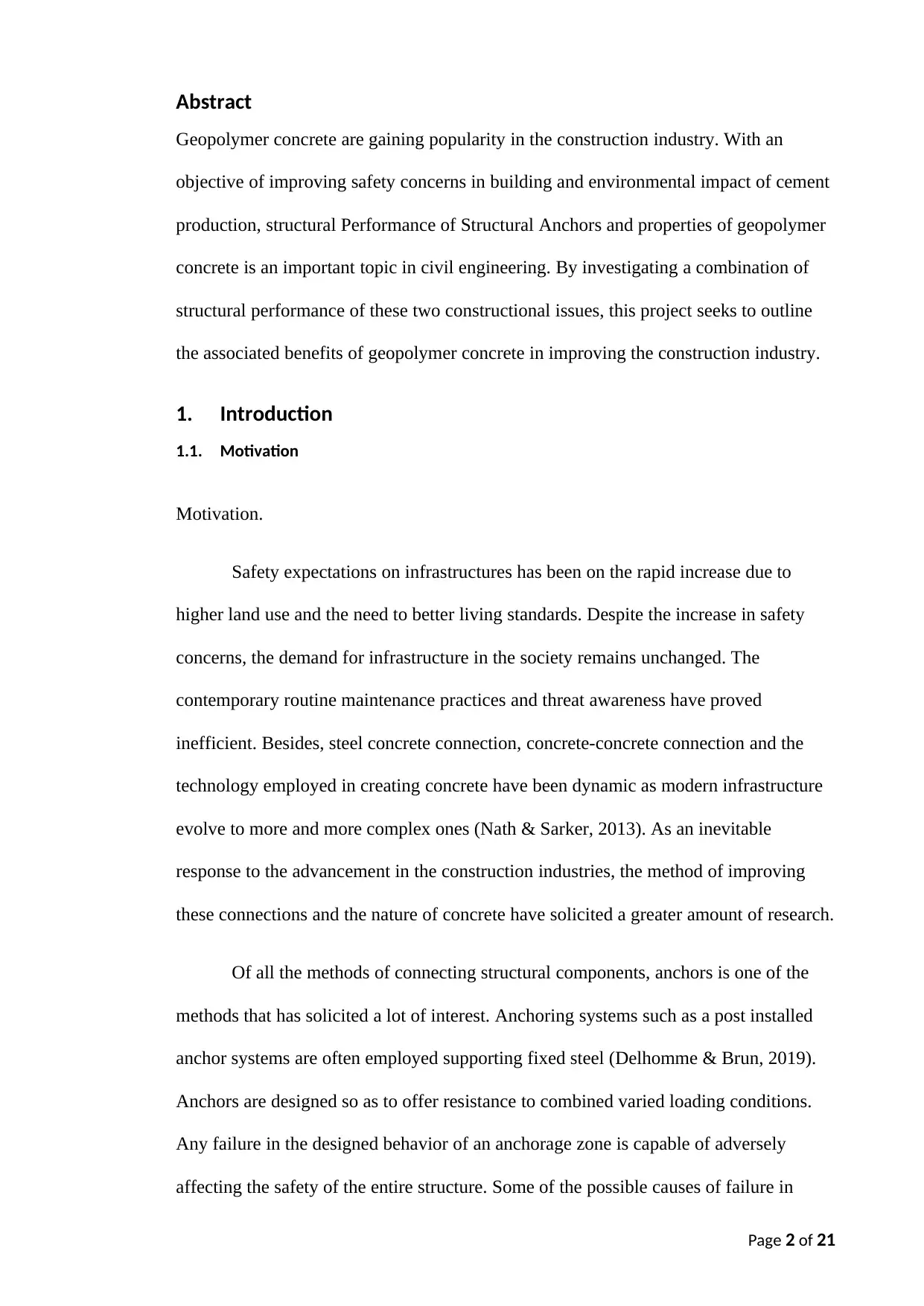
Abstract
Geopolymer concrete are gaining popularity in the construction industry. With an
objective of improving safety concerns in building and environmental impact of cement
production, structural Performance of Structural Anchors and properties of geopolymer
concrete is an important topic in civil engineering. By investigating a combination of
structural performance of these two constructional issues, this project seeks to outline
the associated benefits of geopolymer concrete in improving the construction industry.
1. Introduction
1.1. Motivation
Motivation.
Safety expectations on infrastructures has been on the rapid increase due to
higher land use and the need to better living standards. Despite the increase in safety
concerns, the demand for infrastructure in the society remains unchanged. The
contemporary routine maintenance practices and threat awareness have proved
inefficient. Besides, steel concrete connection, concrete-concrete connection and the
technology employed in creating concrete have been dynamic as modern infrastructure
evolve to more and more complex ones (Nath & Sarker, 2013). As an inevitable
response to the advancement in the construction industries, the method of improving
these connections and the nature of concrete have solicited a greater amount of research.
Of all the methods of connecting structural components, anchors is one of the
methods that has solicited a lot of interest. Anchoring systems such as a post installed
anchor systems are often employed supporting fixed steel (Delhomme & Brun, 2019).
Anchors are designed so as to offer resistance to combined varied loading conditions.
Any failure in the designed behavior of an anchorage zone is capable of adversely
affecting the safety of the entire structure. Some of the possible causes of failure in
Page 2 of 21
Geopolymer concrete are gaining popularity in the construction industry. With an
objective of improving safety concerns in building and environmental impact of cement
production, structural Performance of Structural Anchors and properties of geopolymer
concrete is an important topic in civil engineering. By investigating a combination of
structural performance of these two constructional issues, this project seeks to outline
the associated benefits of geopolymer concrete in improving the construction industry.
1. Introduction
1.1. Motivation
Motivation.
Safety expectations on infrastructures has been on the rapid increase due to
higher land use and the need to better living standards. Despite the increase in safety
concerns, the demand for infrastructure in the society remains unchanged. The
contemporary routine maintenance practices and threat awareness have proved
inefficient. Besides, steel concrete connection, concrete-concrete connection and the
technology employed in creating concrete have been dynamic as modern infrastructure
evolve to more and more complex ones (Nath & Sarker, 2013). As an inevitable
response to the advancement in the construction industries, the method of improving
these connections and the nature of concrete have solicited a greater amount of research.
Of all the methods of connecting structural components, anchors is one of the
methods that has solicited a lot of interest. Anchoring systems such as a post installed
anchor systems are often employed supporting fixed steel (Delhomme & Brun, 2019).
Anchors are designed so as to offer resistance to combined varied loading conditions.
Any failure in the designed behavior of an anchorage zone is capable of adversely
affecting the safety of the entire structure. Some of the possible causes of failure in
Page 2 of 21
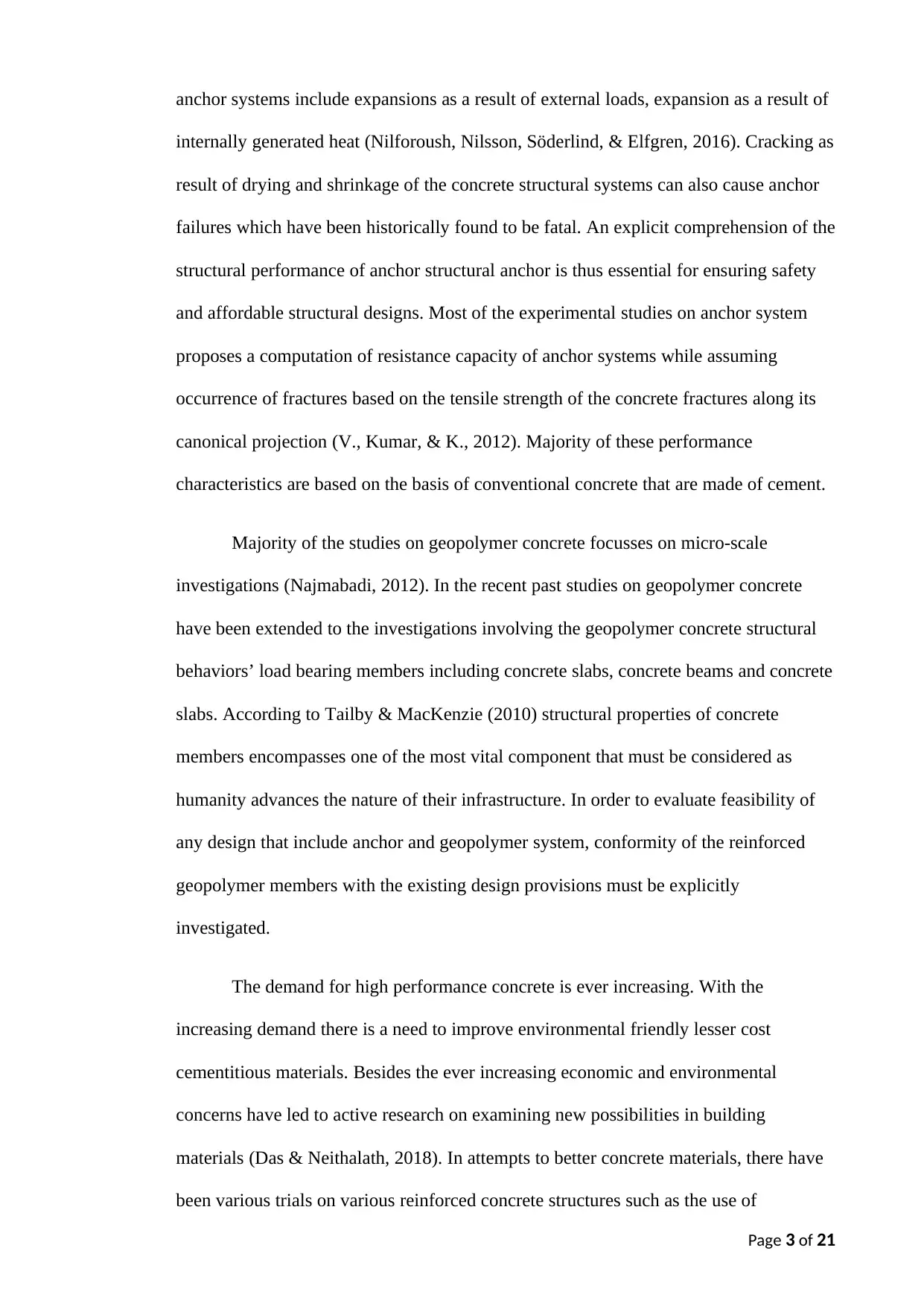
anchor systems include expansions as a result of external loads, expansion as a result of
internally generated heat (Nilforoush, Nilsson, Söderlind, & Elfgren, 2016). Cracking as
result of drying and shrinkage of the concrete structural systems can also cause anchor
failures which have been historically found to be fatal. An explicit comprehension of the
structural performance of anchor structural anchor is thus essential for ensuring safety
and affordable structural designs. Most of the experimental studies on anchor system
proposes a computation of resistance capacity of anchor systems while assuming
occurrence of fractures based on the tensile strength of the concrete fractures along its
canonical projection (V., Kumar, & K., 2012). Majority of these performance
characteristics are based on the basis of conventional concrete that are made of cement.
Majority of the studies on geopolymer concrete focusses on micro-scale
investigations (Najmabadi, 2012). In the recent past studies on geopolymer concrete
have been extended to the investigations involving the geopolymer concrete structural
behaviors’ load bearing members including concrete slabs, concrete beams and concrete
slabs. According to Tailby & MacKenzie (2010) structural properties of concrete
members encompasses one of the most vital component that must be considered as
humanity advances the nature of their infrastructure. In order to evaluate feasibility of
any design that include anchor and geopolymer system, conformity of the reinforced
geopolymer members with the existing design provisions must be explicitly
investigated.
The demand for high performance concrete is ever increasing. With the
increasing demand there is a need to improve environmental friendly lesser cost
cementitious materials. Besides the ever increasing economic and environmental
concerns have led to active research on examining new possibilities in building
materials (Das & Neithalath, 2018). In attempts to better concrete materials, there have
been various trials on various reinforced concrete structures such as the use of
Page 3 of 21
internally generated heat (Nilforoush, Nilsson, Söderlind, & Elfgren, 2016). Cracking as
result of drying and shrinkage of the concrete structural systems can also cause anchor
failures which have been historically found to be fatal. An explicit comprehension of the
structural performance of anchor structural anchor is thus essential for ensuring safety
and affordable structural designs. Most of the experimental studies on anchor system
proposes a computation of resistance capacity of anchor systems while assuming
occurrence of fractures based on the tensile strength of the concrete fractures along its
canonical projection (V., Kumar, & K., 2012). Majority of these performance
characteristics are based on the basis of conventional concrete that are made of cement.
Majority of the studies on geopolymer concrete focusses on micro-scale
investigations (Najmabadi, 2012). In the recent past studies on geopolymer concrete
have been extended to the investigations involving the geopolymer concrete structural
behaviors’ load bearing members including concrete slabs, concrete beams and concrete
slabs. According to Tailby & MacKenzie (2010) structural properties of concrete
members encompasses one of the most vital component that must be considered as
humanity advances the nature of their infrastructure. In order to evaluate feasibility of
any design that include anchor and geopolymer system, conformity of the reinforced
geopolymer members with the existing design provisions must be explicitly
investigated.
The demand for high performance concrete is ever increasing. With the
increasing demand there is a need to improve environmental friendly lesser cost
cementitious materials. Besides the ever increasing economic and environmental
concerns have led to active research on examining new possibilities in building
materials (Das & Neithalath, 2018). In attempts to better concrete materials, there have
been various trials on various reinforced concrete structures such as the use of
Page 3 of 21
⊘ This is a preview!⊘
Do you want full access?
Subscribe today to unlock all pages.

Trusted by 1+ million students worldwide
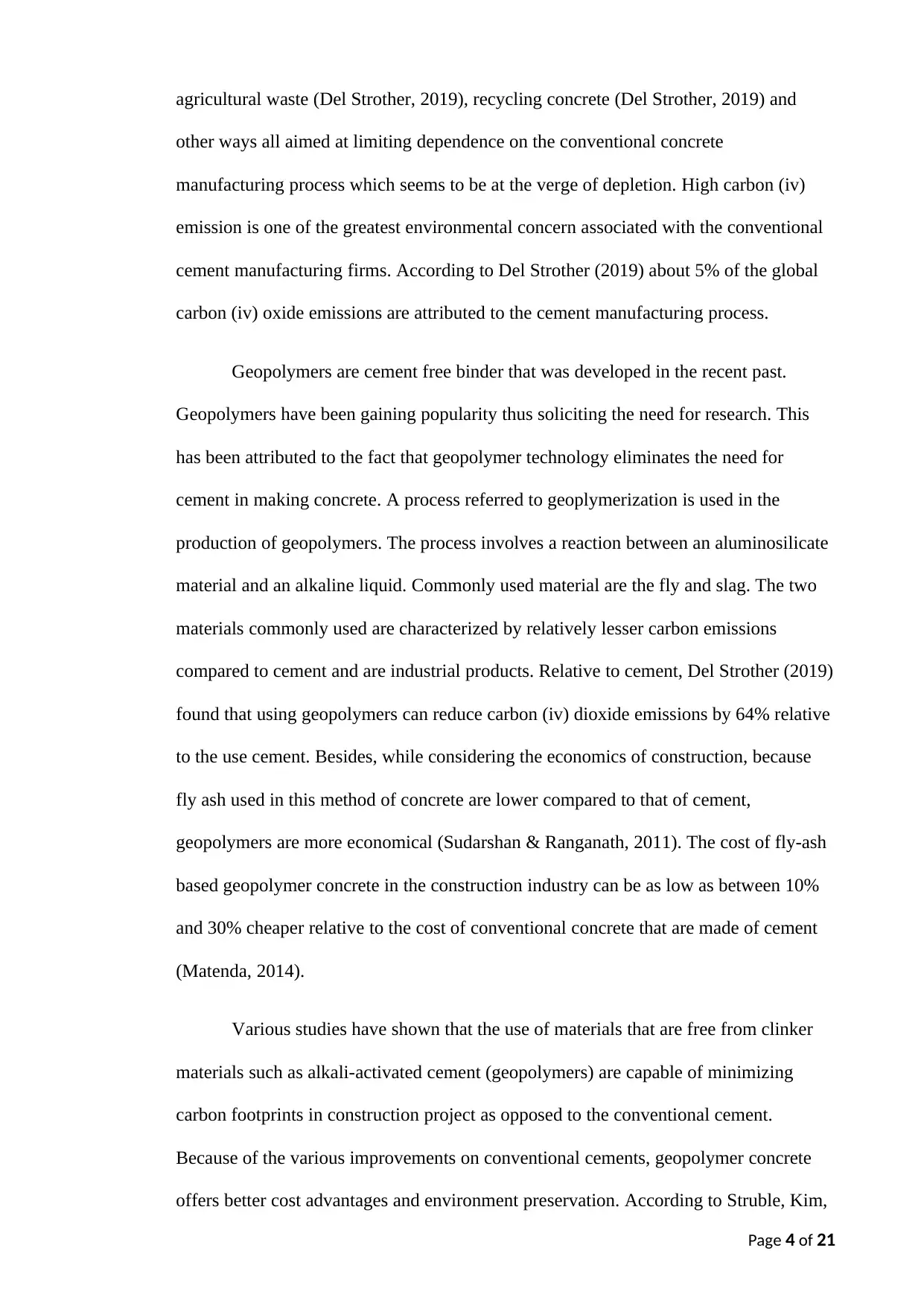
agricultural waste (Del Strother, 2019), recycling concrete (Del Strother, 2019) and
other ways all aimed at limiting dependence on the conventional concrete
manufacturing process which seems to be at the verge of depletion. High carbon (iv)
emission is one of the greatest environmental concern associated with the conventional
cement manufacturing firms. According to Del Strother (2019) about 5% of the global
carbon (iv) oxide emissions are attributed to the cement manufacturing process.
Geopolymers are cement free binder that was developed in the recent past.
Geopolymers have been gaining popularity thus soliciting the need for research. This
has been attributed to the fact that geopolymer technology eliminates the need for
cement in making concrete. A process referred to geoplymerization is used in the
production of geopolymers. The process involves a reaction between an aluminosilicate
material and an alkaline liquid. Commonly used material are the fly and slag. The two
materials commonly used are characterized by relatively lesser carbon emissions
compared to cement and are industrial products. Relative to cement, Del Strother (2019)
found that using geopolymers can reduce carbon (iv) dioxide emissions by 64% relative
to the use cement. Besides, while considering the economics of construction, because
fly ash used in this method of concrete are lower compared to that of cement,
geopolymers are more economical (Sudarshan & Ranganath, 2011). The cost of fly-ash
based geopolymer concrete in the construction industry can be as low as between 10%
and 30% cheaper relative to the cost of conventional concrete that are made of cement
(Matenda, 2014).
Various studies have shown that the use of materials that are free from clinker
materials such as alkali-activated cement (geopolymers) are capable of minimizing
carbon footprints in construction project as opposed to the conventional cement.
Because of the various improvements on conventional cements, geopolymer concrete
offers better cost advantages and environment preservation. According to Struble, Kim,
Page 4 of 21
other ways all aimed at limiting dependence on the conventional concrete
manufacturing process which seems to be at the verge of depletion. High carbon (iv)
emission is one of the greatest environmental concern associated with the conventional
cement manufacturing firms. According to Del Strother (2019) about 5% of the global
carbon (iv) oxide emissions are attributed to the cement manufacturing process.
Geopolymers are cement free binder that was developed in the recent past.
Geopolymers have been gaining popularity thus soliciting the need for research. This
has been attributed to the fact that geopolymer technology eliminates the need for
cement in making concrete. A process referred to geoplymerization is used in the
production of geopolymers. The process involves a reaction between an aluminosilicate
material and an alkaline liquid. Commonly used material are the fly and slag. The two
materials commonly used are characterized by relatively lesser carbon emissions
compared to cement and are industrial products. Relative to cement, Del Strother (2019)
found that using geopolymers can reduce carbon (iv) dioxide emissions by 64% relative
to the use cement. Besides, while considering the economics of construction, because
fly ash used in this method of concrete are lower compared to that of cement,
geopolymers are more economical (Sudarshan & Ranganath, 2011). The cost of fly-ash
based geopolymer concrete in the construction industry can be as low as between 10%
and 30% cheaper relative to the cost of conventional concrete that are made of cement
(Matenda, 2014).
Various studies have shown that the use of materials that are free from clinker
materials such as alkali-activated cement (geopolymers) are capable of minimizing
carbon footprints in construction project as opposed to the conventional cement.
Because of the various improvements on conventional cements, geopolymer concrete
offers better cost advantages and environment preservation. According to Struble, Kim,
Page 4 of 21
Paraphrase This Document
Need a fresh take? Get an instant paraphrase of this document with our AI Paraphraser
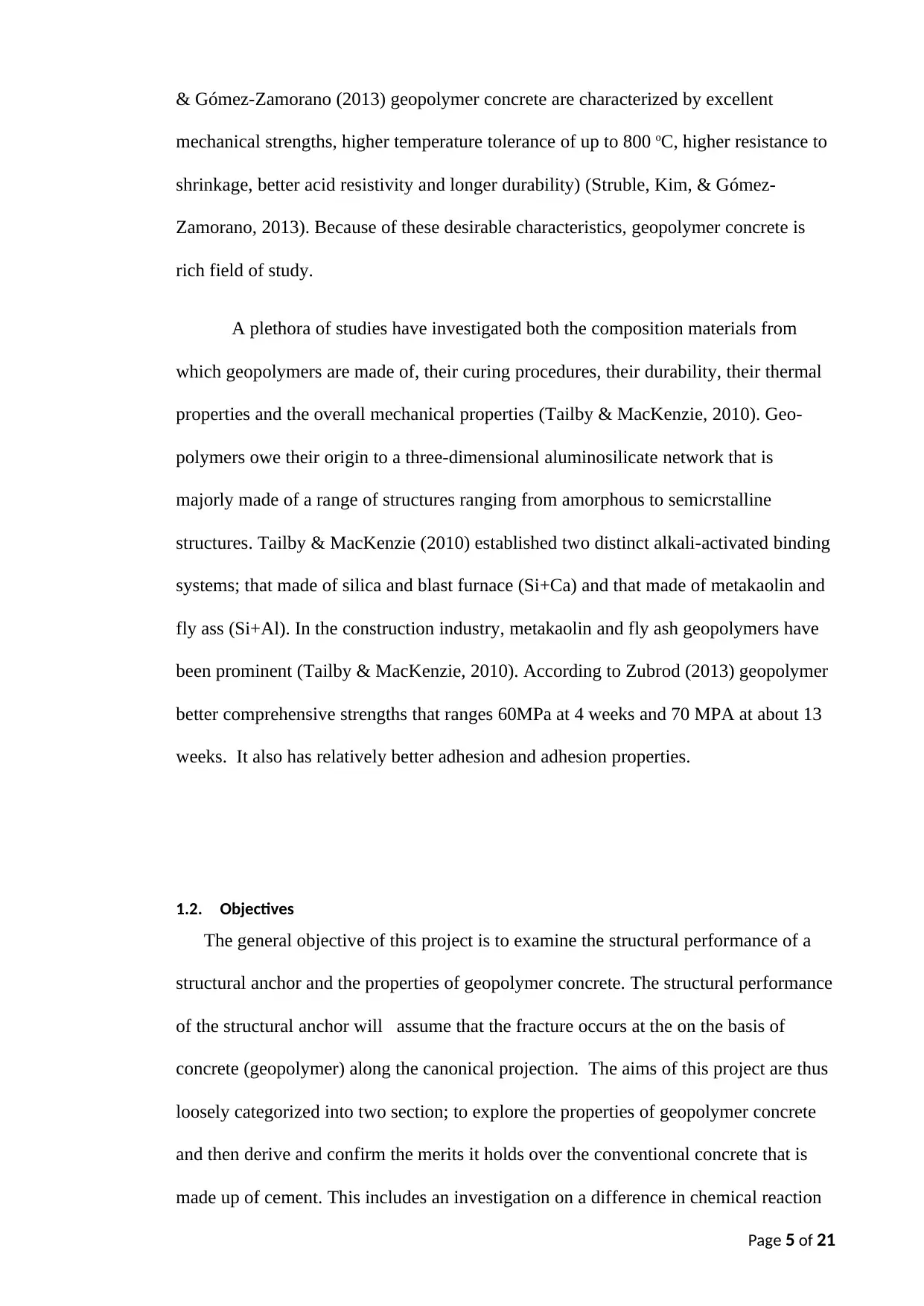
& Gómez-Zamorano (2013) geopolymer concrete are characterized by excellent
mechanical strengths, higher temperature tolerance of up to 800 oC, higher resistance to
shrinkage, better acid resistivity and longer durability) (Struble, Kim, & Gómez-
Zamorano, 2013). Because of these desirable characteristics, geopolymer concrete is
rich field of study.
A plethora of studies have investigated both the composition materials from
which geopolymers are made of, their curing procedures, their durability, their thermal
properties and the overall mechanical properties (Tailby & MacKenzie, 2010). Geo-
polymers owe their origin to a three-dimensional aluminosilicate network that is
majorly made of a range of structures ranging from amorphous to semicrstalline
structures. Tailby & MacKenzie (2010) established two distinct alkali-activated binding
systems; that made of silica and blast furnace (Si+Ca) and that made of metakaolin and
fly ass (Si+Al). In the construction industry, metakaolin and fly ash geopolymers have
been prominent (Tailby & MacKenzie, 2010). According to Zubrod (2013) geopolymer
better comprehensive strengths that ranges 60MPa at 4 weeks and 70 MPA at about 13
weeks. It also has relatively better adhesion and adhesion properties.
1.2. Objectives
The general objective of this project is to examine the structural performance of a
structural anchor and the properties of geopolymer concrete. The structural performance
of the structural anchor will assume that the fracture occurs at the on the basis of
concrete (geopolymer) along the canonical projection. The aims of this project are thus
loosely categorized into two section; to explore the properties of geopolymer concrete
and then derive and confirm the merits it holds over the conventional concrete that is
made up of cement. This includes an investigation on a difference in chemical reaction
Page 5 of 21
mechanical strengths, higher temperature tolerance of up to 800 oC, higher resistance to
shrinkage, better acid resistivity and longer durability) (Struble, Kim, & Gómez-
Zamorano, 2013). Because of these desirable characteristics, geopolymer concrete is
rich field of study.
A plethora of studies have investigated both the composition materials from
which geopolymers are made of, their curing procedures, their durability, their thermal
properties and the overall mechanical properties (Tailby & MacKenzie, 2010). Geo-
polymers owe their origin to a three-dimensional aluminosilicate network that is
majorly made of a range of structures ranging from amorphous to semicrstalline
structures. Tailby & MacKenzie (2010) established two distinct alkali-activated binding
systems; that made of silica and blast furnace (Si+Ca) and that made of metakaolin and
fly ass (Si+Al). In the construction industry, metakaolin and fly ash geopolymers have
been prominent (Tailby & MacKenzie, 2010). According to Zubrod (2013) geopolymer
better comprehensive strengths that ranges 60MPa at 4 weeks and 70 MPA at about 13
weeks. It also has relatively better adhesion and adhesion properties.
1.2. Objectives
The general objective of this project is to examine the structural performance of a
structural anchor and the properties of geopolymer concrete. The structural performance
of the structural anchor will assume that the fracture occurs at the on the basis of
concrete (geopolymer) along the canonical projection. The aims of this project are thus
loosely categorized into two section; to explore the properties of geopolymer concrete
and then derive and confirm the merits it holds over the conventional concrete that is
made up of cement. This includes an investigation on a difference in chemical reaction
Page 5 of 21
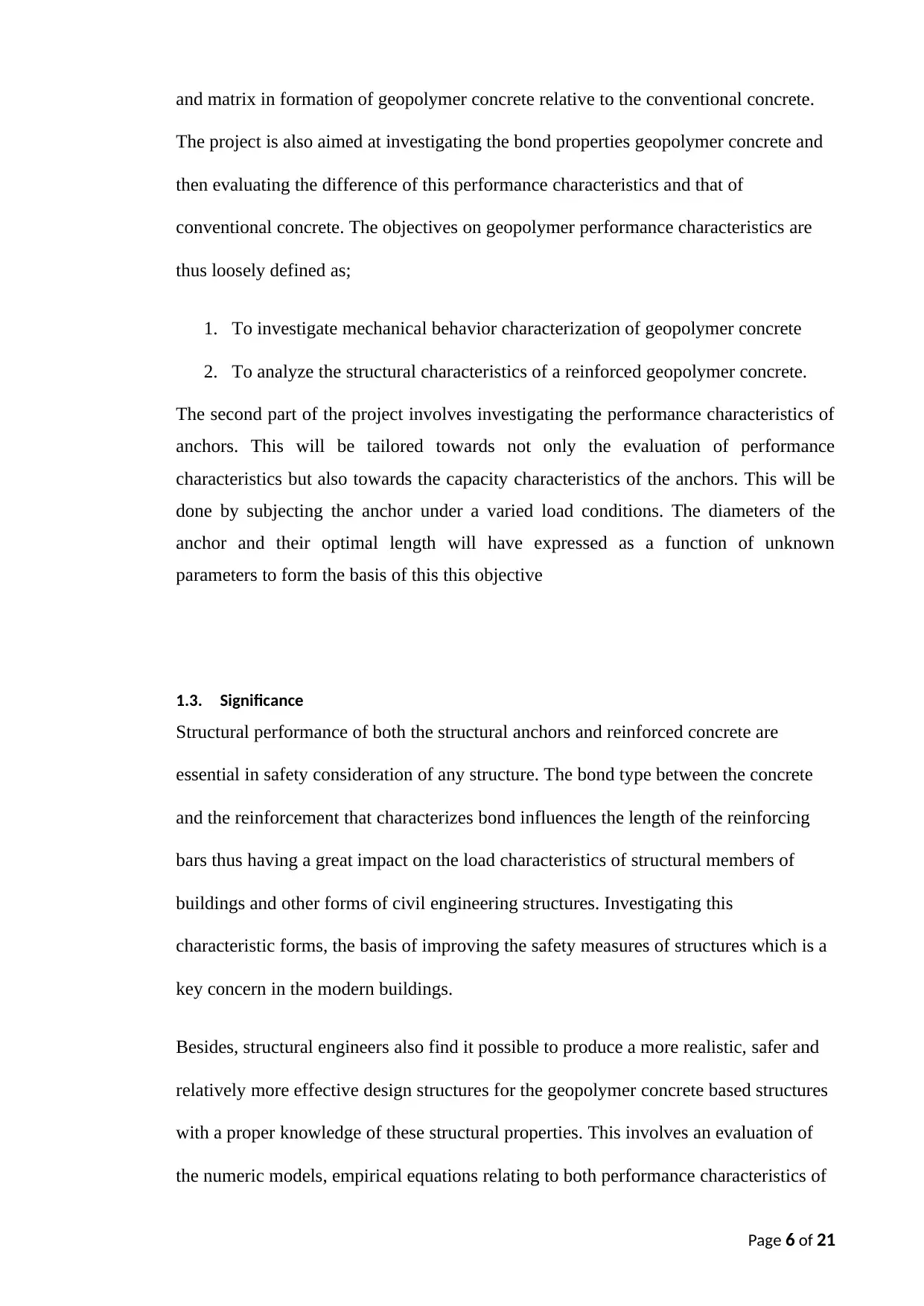
and matrix in formation of geopolymer concrete relative to the conventional concrete.
The project is also aimed at investigating the bond properties geopolymer concrete and
then evaluating the difference of this performance characteristics and that of
conventional concrete. The objectives on geopolymer performance characteristics are
thus loosely defined as;
1. To investigate mechanical behavior characterization of geopolymer concrete
2. To analyze the structural characteristics of a reinforced geopolymer concrete.
The second part of the project involves investigating the performance characteristics of
anchors. This will be tailored towards not only the evaluation of performance
characteristics but also towards the capacity characteristics of the anchors. This will be
done by subjecting the anchor under a varied load conditions. The diameters of the
anchor and their optimal length will have expressed as a function of unknown
parameters to form the basis of this this objective
1.3. Significance
Structural performance of both the structural anchors and reinforced concrete are
essential in safety consideration of any structure. The bond type between the concrete
and the reinforcement that characterizes bond influences the length of the reinforcing
bars thus having a great impact on the load characteristics of structural members of
buildings and other forms of civil engineering structures. Investigating this
characteristic forms, the basis of improving the safety measures of structures which is a
key concern in the modern buildings.
Besides, structural engineers also find it possible to produce a more realistic, safer and
relatively more effective design structures for the geopolymer concrete based structures
with a proper knowledge of these structural properties. This involves an evaluation of
the numeric models, empirical equations relating to both performance characteristics of
Page 6 of 21
The project is also aimed at investigating the bond properties geopolymer concrete and
then evaluating the difference of this performance characteristics and that of
conventional concrete. The objectives on geopolymer performance characteristics are
thus loosely defined as;
1. To investigate mechanical behavior characterization of geopolymer concrete
2. To analyze the structural characteristics of a reinforced geopolymer concrete.
The second part of the project involves investigating the performance characteristics of
anchors. This will be tailored towards not only the evaluation of performance
characteristics but also towards the capacity characteristics of the anchors. This will be
done by subjecting the anchor under a varied load conditions. The diameters of the
anchor and their optimal length will have expressed as a function of unknown
parameters to form the basis of this this objective
1.3. Significance
Structural performance of both the structural anchors and reinforced concrete are
essential in safety consideration of any structure. The bond type between the concrete
and the reinforcement that characterizes bond influences the length of the reinforcing
bars thus having a great impact on the load characteristics of structural members of
buildings and other forms of civil engineering structures. Investigating this
characteristic forms, the basis of improving the safety measures of structures which is a
key concern in the modern buildings.
Besides, structural engineers also find it possible to produce a more realistic, safer and
relatively more effective design structures for the geopolymer concrete based structures
with a proper knowledge of these structural properties. This involves an evaluation of
the numeric models, empirical equations relating to both performance characteristics of
Page 6 of 21
⊘ This is a preview!⊘
Do you want full access?
Subscribe today to unlock all pages.

Trusted by 1+ million students worldwide
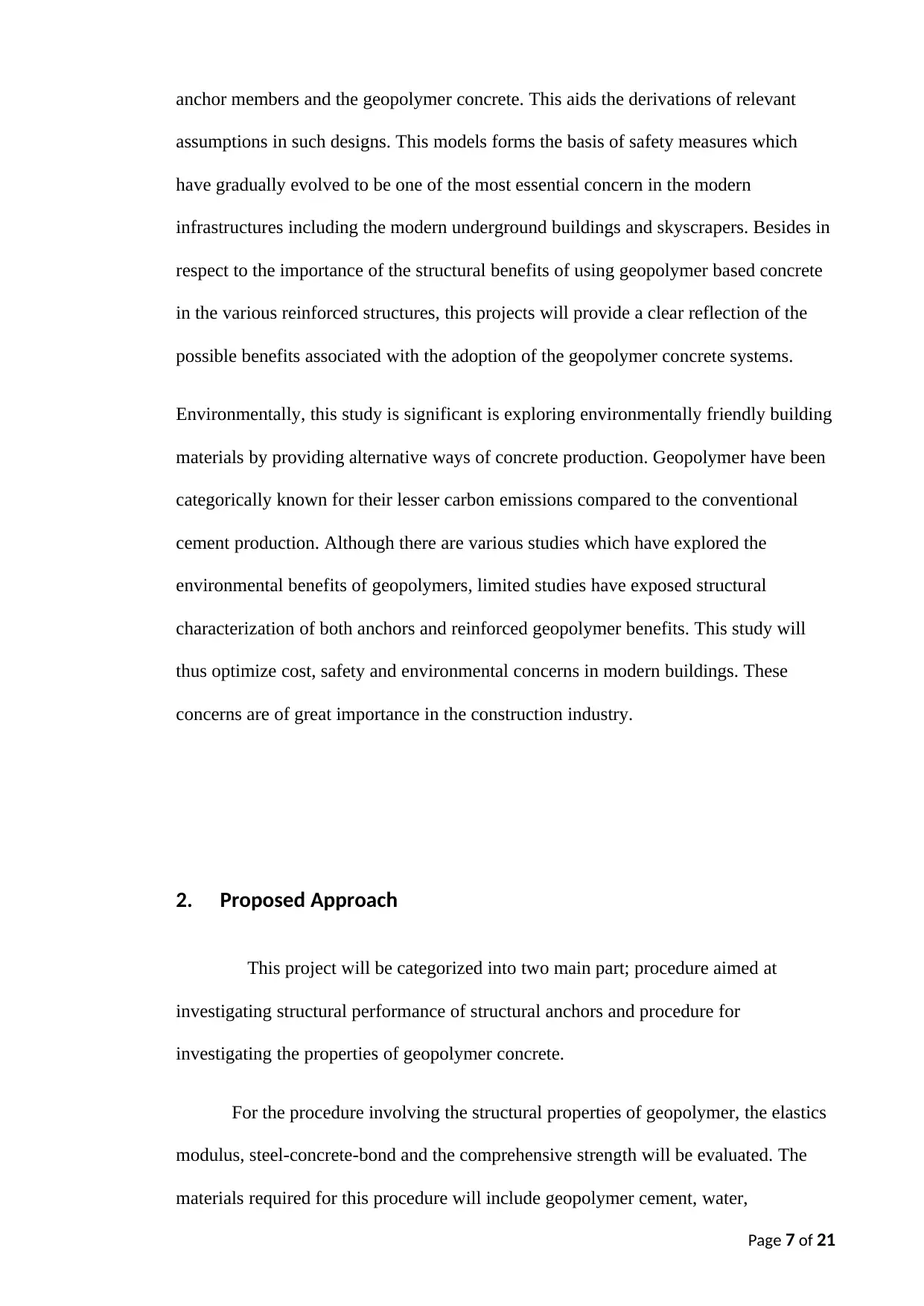
anchor members and the geopolymer concrete. This aids the derivations of relevant
assumptions in such designs. This models forms the basis of safety measures which
have gradually evolved to be one of the most essential concern in the modern
infrastructures including the modern underground buildings and skyscrapers. Besides in
respect to the importance of the structural benefits of using geopolymer based concrete
in the various reinforced structures, this projects will provide a clear reflection of the
possible benefits associated with the adoption of the geopolymer concrete systems.
Environmentally, this study is significant is exploring environmentally friendly building
materials by providing alternative ways of concrete production. Geopolymer have been
categorically known for their lesser carbon emissions compared to the conventional
cement production. Although there are various studies which have explored the
environmental benefits of geopolymers, limited studies have exposed structural
characterization of both anchors and reinforced geopolymer benefits. This study will
thus optimize cost, safety and environmental concerns in modern buildings. These
concerns are of great importance in the construction industry.
2. Proposed Approach
This project will be categorized into two main part; procedure aimed at
investigating structural performance of structural anchors and procedure for
investigating the properties of geopolymer concrete.
For the procedure involving the structural properties of geopolymer, the elastics
modulus, steel-concrete-bond and the comprehensive strength will be evaluated. The
materials required for this procedure will include geopolymer cement, water,
Page 7 of 21
assumptions in such designs. This models forms the basis of safety measures which
have gradually evolved to be one of the most essential concern in the modern
infrastructures including the modern underground buildings and skyscrapers. Besides in
respect to the importance of the structural benefits of using geopolymer based concrete
in the various reinforced structures, this projects will provide a clear reflection of the
possible benefits associated with the adoption of the geopolymer concrete systems.
Environmentally, this study is significant is exploring environmentally friendly building
materials by providing alternative ways of concrete production. Geopolymer have been
categorically known for their lesser carbon emissions compared to the conventional
cement production. Although there are various studies which have explored the
environmental benefits of geopolymers, limited studies have exposed structural
characterization of both anchors and reinforced geopolymer benefits. This study will
thus optimize cost, safety and environmental concerns in modern buildings. These
concerns are of great importance in the construction industry.
2. Proposed Approach
This project will be categorized into two main part; procedure aimed at
investigating structural performance of structural anchors and procedure for
investigating the properties of geopolymer concrete.
For the procedure involving the structural properties of geopolymer, the elastics
modulus, steel-concrete-bond and the comprehensive strength will be evaluated. The
materials required for this procedure will include geopolymer cement, water,
Page 7 of 21
Paraphrase This Document
Need a fresh take? Get an instant paraphrase of this document with our AI Paraphraser
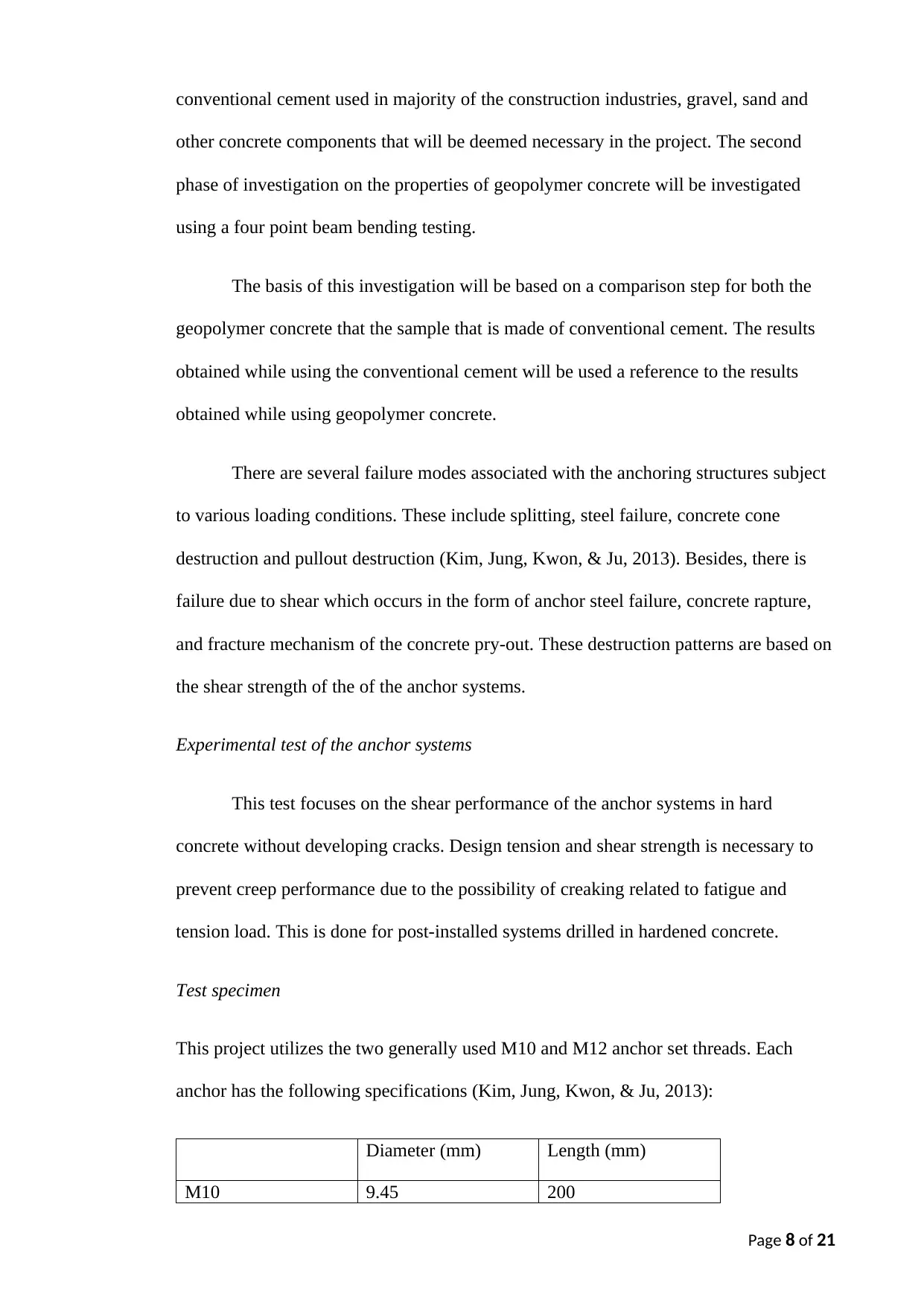
conventional cement used in majority of the construction industries, gravel, sand and
other concrete components that will be deemed necessary in the project. The second
phase of investigation on the properties of geopolymer concrete will be investigated
using a four point beam bending testing.
The basis of this investigation will be based on a comparison step for both the
geopolymer concrete that the sample that is made of conventional cement. The results
obtained while using the conventional cement will be used a reference to the results
obtained while using geopolymer concrete.
There are several failure modes associated with the anchoring structures subject
to various loading conditions. These include splitting, steel failure, concrete cone
destruction and pullout destruction (Kim, Jung, Kwon, & Ju, 2013). Besides, there is
failure due to shear which occurs in the form of anchor steel failure, concrete rapture,
and fracture mechanism of the concrete pry-out. These destruction patterns are based on
the shear strength of the of the anchor systems.
Experimental test of the anchor systems
This test focuses on the shear performance of the anchor systems in hard
concrete without developing cracks. Design tension and shear strength is necessary to
prevent creep performance due to the possibility of creaking related to fatigue and
tension load. This is done for post-installed systems drilled in hardened concrete.
Test specimen
This project utilizes the two generally used M10 and M12 anchor set threads. Each
anchor has the following specifications (Kim, Jung, Kwon, & Ju, 2013):
Diameter (mm) Length (mm)
M10 9.45 200
Page 8 of 21
other concrete components that will be deemed necessary in the project. The second
phase of investigation on the properties of geopolymer concrete will be investigated
using a four point beam bending testing.
The basis of this investigation will be based on a comparison step for both the
geopolymer concrete that the sample that is made of conventional cement. The results
obtained while using the conventional cement will be used a reference to the results
obtained while using geopolymer concrete.
There are several failure modes associated with the anchoring structures subject
to various loading conditions. These include splitting, steel failure, concrete cone
destruction and pullout destruction (Kim, Jung, Kwon, & Ju, 2013). Besides, there is
failure due to shear which occurs in the form of anchor steel failure, concrete rapture,
and fracture mechanism of the concrete pry-out. These destruction patterns are based on
the shear strength of the of the anchor systems.
Experimental test of the anchor systems
This test focuses on the shear performance of the anchor systems in hard
concrete without developing cracks. Design tension and shear strength is necessary to
prevent creep performance due to the possibility of creaking related to fatigue and
tension load. This is done for post-installed systems drilled in hardened concrete.
Test specimen
This project utilizes the two generally used M10 and M12 anchor set threads. Each
anchor has the following specifications (Kim, Jung, Kwon, & Ju, 2013):
Diameter (mm) Length (mm)
M10 9.45 200
Page 8 of 21
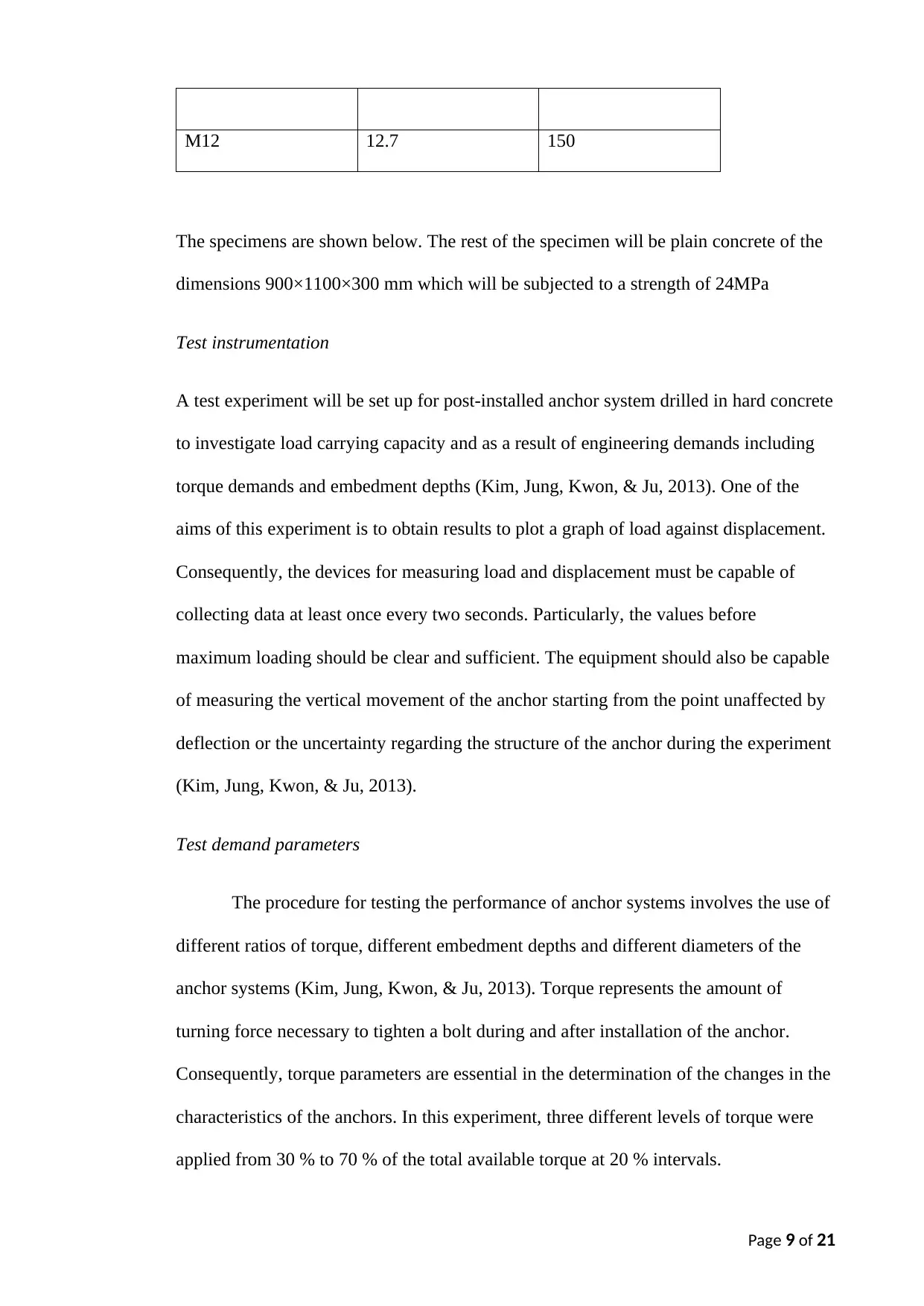
M12 12.7 150
The specimens are shown below. The rest of the specimen will be plain concrete of the
dimensions 900×1100×300 mm which will be subjected to a strength of 24MPa
Test instrumentation
A test experiment will be set up for post-installed anchor system drilled in hard concrete
to investigate load carrying capacity and as a result of engineering demands including
torque demands and embedment depths (Kim, Jung, Kwon, & Ju, 2013). One of the
aims of this experiment is to obtain results to plot a graph of load against displacement.
Consequently, the devices for measuring load and displacement must be capable of
collecting data at least once every two seconds. Particularly, the values before
maximum loading should be clear and sufficient. The equipment should also be capable
of measuring the vertical movement of the anchor starting from the point unaffected by
deflection or the uncertainty regarding the structure of the anchor during the experiment
(Kim, Jung, Kwon, & Ju, 2013).
Test demand parameters
The procedure for testing the performance of anchor systems involves the use of
different ratios of torque, different embedment depths and different diameters of the
anchor systems (Kim, Jung, Kwon, & Ju, 2013). Torque represents the amount of
turning force necessary to tighten a bolt during and after installation of the anchor.
Consequently, torque parameters are essential in the determination of the changes in the
characteristics of the anchors. In this experiment, three different levels of torque were
applied from 30 % to 70 % of the total available torque at 20 % intervals.
Page 9 of 21
The specimens are shown below. The rest of the specimen will be plain concrete of the
dimensions 900×1100×300 mm which will be subjected to a strength of 24MPa
Test instrumentation
A test experiment will be set up for post-installed anchor system drilled in hard concrete
to investigate load carrying capacity and as a result of engineering demands including
torque demands and embedment depths (Kim, Jung, Kwon, & Ju, 2013). One of the
aims of this experiment is to obtain results to plot a graph of load against displacement.
Consequently, the devices for measuring load and displacement must be capable of
collecting data at least once every two seconds. Particularly, the values before
maximum loading should be clear and sufficient. The equipment should also be capable
of measuring the vertical movement of the anchor starting from the point unaffected by
deflection or the uncertainty regarding the structure of the anchor during the experiment
(Kim, Jung, Kwon, & Ju, 2013).
Test demand parameters
The procedure for testing the performance of anchor systems involves the use of
different ratios of torque, different embedment depths and different diameters of the
anchor systems (Kim, Jung, Kwon, & Ju, 2013). Torque represents the amount of
turning force necessary to tighten a bolt during and after installation of the anchor.
Consequently, torque parameters are essential in the determination of the changes in the
characteristics of the anchors. In this experiment, three different levels of torque were
applied from 30 % to 70 % of the total available torque at 20 % intervals.
Page 9 of 21
⊘ This is a preview!⊘
Do you want full access?
Subscribe today to unlock all pages.

Trusted by 1+ million students worldwide

Results and analysis
The following methods and tools will be used to analyze the results from the
experimental tests in order to draw meaningful conclusions and to put forward
reasonable recommendations.
Non linearity of the concrete system
This analysis uses the Concrete Damaged Plasticity Model in order to capture
the damage mechanism for the concrete structure. This model was first developed in
1989 and improved in 1998 by Lee and Fenvas. This model is selected because it shows
the nonlinear tension properties of the material as well as complexities of compressions
and material failure. The figure below shows concrete nonlinear model contrasted with
the nonlinear model of steel.
Page 10 of 21
The following methods and tools will be used to analyze the results from the
experimental tests in order to draw meaningful conclusions and to put forward
reasonable recommendations.
Non linearity of the concrete system
This analysis uses the Concrete Damaged Plasticity Model in order to capture
the damage mechanism for the concrete structure. This model was first developed in
1989 and improved in 1998 by Lee and Fenvas. This model is selected because it shows
the nonlinear tension properties of the material as well as complexities of compressions
and material failure. The figure below shows concrete nonlinear model contrasted with
the nonlinear model of steel.
Page 10 of 21
Paraphrase This Document
Need a fresh take? Get an instant paraphrase of this document with our AI Paraphraser
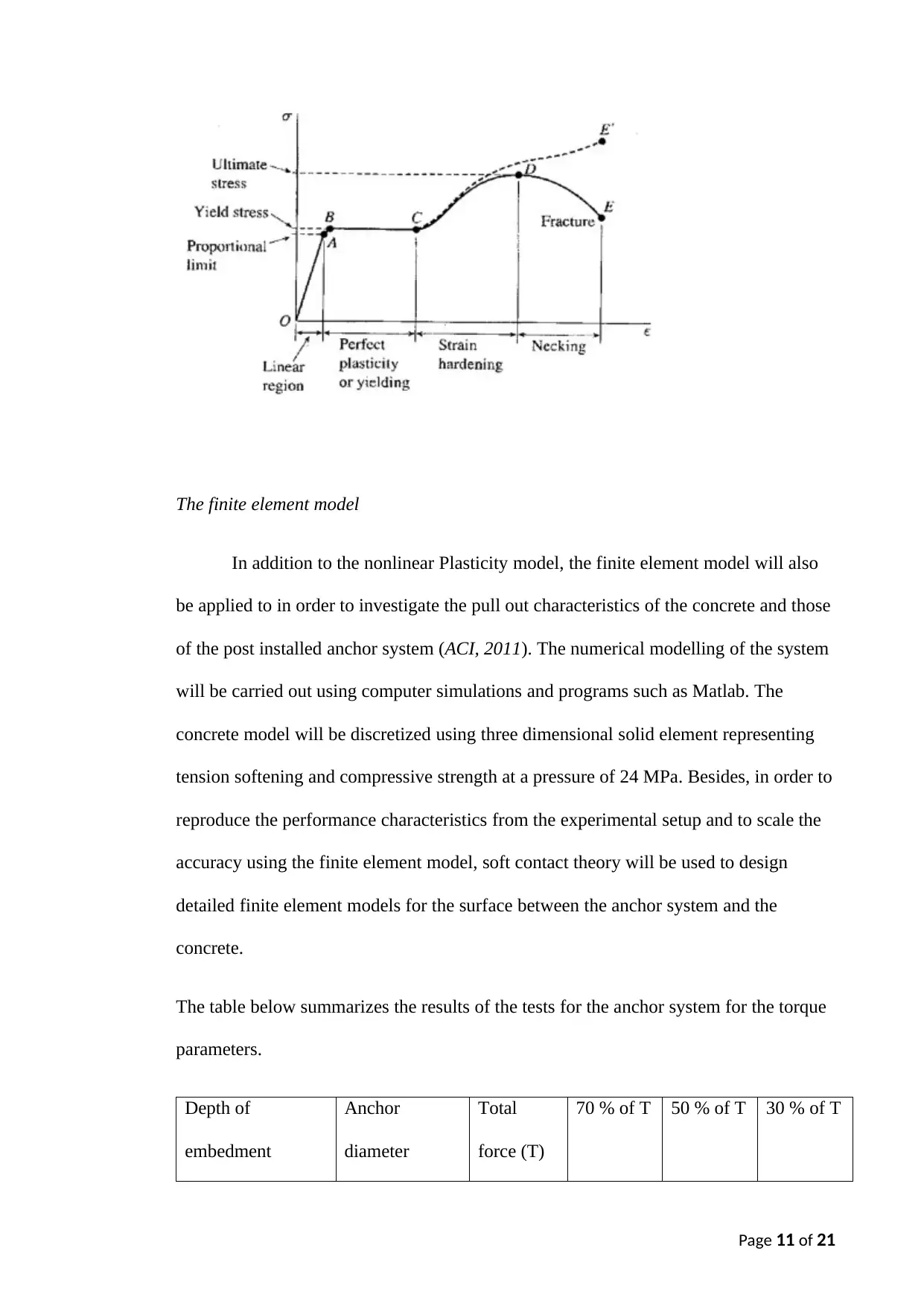
The finite element model
In addition to the nonlinear Plasticity model, the finite element model will also
be applied to in order to investigate the pull out characteristics of the concrete and those
of the post installed anchor system (ACI, 2011). The numerical modelling of the system
will be carried out using computer simulations and programs such as Matlab. The
concrete model will be discretized using three dimensional solid element representing
tension softening and compressive strength at a pressure of 24 MPa. Besides, in order to
reproduce the performance characteristics from the experimental setup and to scale the
accuracy using the finite element model, soft contact theory will be used to design
detailed finite element models for the surface between the anchor system and the
concrete.
The table below summarizes the results of the tests for the anchor system for the torque
parameters.
Depth of
embedment
Anchor
diameter
Total
force (T)
70 % of T 50 % of T 30 % of T
Page 11 of 21
In addition to the nonlinear Plasticity model, the finite element model will also
be applied to in order to investigate the pull out characteristics of the concrete and those
of the post installed anchor system (ACI, 2011). The numerical modelling of the system
will be carried out using computer simulations and programs such as Matlab. The
concrete model will be discretized using three dimensional solid element representing
tension softening and compressive strength at a pressure of 24 MPa. Besides, in order to
reproduce the performance characteristics from the experimental setup and to scale the
accuracy using the finite element model, soft contact theory will be used to design
detailed finite element models for the surface between the anchor system and the
concrete.
The table below summarizes the results of the tests for the anchor system for the torque
parameters.
Depth of
embedment
Anchor
diameter
Total
force (T)
70 % of T 50 % of T 30 % of T
Page 11 of 21

50
100
50
100
The table below summarizes the material properties for steel and concrete.
Material Young’s modulus Poison’s ratio
Steel
Concrete
Shear test results
Specimen Load displacement
Pull out test results
Specimen Load displacement
Page 12 of 21
100
50
100
The table below summarizes the material properties for steel and concrete.
Material Young’s modulus Poison’s ratio
Steel
Concrete
Shear test results
Specimen Load displacement
Pull out test results
Specimen Load displacement
Page 12 of 21
⊘ This is a preview!⊘
Do you want full access?
Subscribe today to unlock all pages.

Trusted by 1+ million students worldwide
1 out of 21
Related Documents
Your All-in-One AI-Powered Toolkit for Academic Success.
+13062052269
info@desklib.com
Available 24*7 on WhatsApp / Email
![[object Object]](/_next/static/media/star-bottom.7253800d.svg)
Unlock your academic potential
Copyright © 2020–2025 A2Z Services. All Rights Reserved. Developed and managed by ZUCOL.





